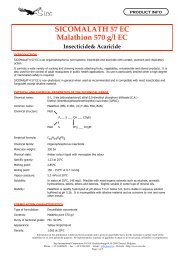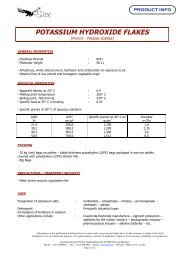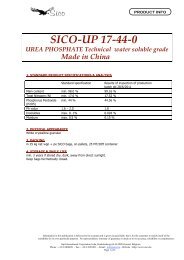POLYSULPHATE⢠- Sico
POLYSULPHATE⢠- Sico
POLYSULPHATE⢠- Sico
Create successful ePaper yourself
Turn your PDF publications into a flip-book with our unique Google optimized e-Paper software.
PRODUCT INFOPOLYSULPHATE14% K 2 O + 6% MgO + 17% CaO + 48% SO 3A new granular 2-4 mm sulphate fertiliser for better crops.Low chloride, suitable for organic agriculture.1/ PRODUCT DESCRIPTIONPolysulphate is a new naturally occurring mineral fertiliser containing the sulphates of potassium,magnesium and calcium. It is a complex crystal granular product which has been discovered in potashmines at a depth of 1300 metres in potash mines in the UK and in a few other places in the world.Polysulphate has these minimum contents of :- Sulphur : 48% SO 3 as sulphate- Potassium : 14% K 2 O as from potassium sulphate- Magnesium : 6% MgO as from magnesium sulphate- Calcium : 17% CaO as from calcium sulphate2/ ADVANTAGES- concentrated sulphur source for low application rates- readily available sulphur plus potassium and magnesium- naturally occurring productNutrients are fully available to plants.Extensive trial work has confirmed that the principal nutrients of sulphate, potash and magnesium inPolysulphate are fully available to plants, performing in trials with the same plant-efficiency asstandard sources of potassium and magnesium sulphate.3/ SOME APPLICATION ADVICENatural, sustainable, dependableAvailable in its natural form, Polysulphate has a low carbon footprint. It deliversdependable high value, for low environmental impact.Unlike blended or compound fertiliser, Polysulphate is available in its natural state. It is mined,crushed, screened and bagged, involving no chemical separation or other industrial processes.It is therefore an ideal natural source for all crops, especially brassicas, cereals, pulses, fieldvegetables, clover-rich grassland leys and silage crops. The low content of the crop nutrient chloridemakes it ideal for use on chloridesensitive crops.The natural process by which Polysulphate is produced makes it a low carbonfootprint fertiliser. Thishelps growers achieve carbon targets demanded by retailers and some food processors.There’s an estimated one billion tonnes available, mined in Europe. As global demand for sulphatefertilisers increases, this provides farmers throughout Europe with a dependable source,rather than a by-product material.Information in this publication is believed to be accurate and is given in good faith, but is for the customer to satisfy itself of thesuitability for its own particular purpose. No representation, warranty of guarantee is made as to its accuracy, reliability or completeness.Sap International bvba, Krekelenberg 69, B-2980 Zoersel, BelgiumPhone : +32/3/3090651 – Fax : +32/3/3091931 – Email : info@sico.be - Website : Http://www.sico.bePage 1 of 2
PRODUCT INFOPolysulphate calculatorUse the chart below to decide how much you need, and how much potash and magnesiumyour application will provide.Risk ofdeficiencyAdvised rate (kg/ha) Other nutrientsapplied (kg/ha)SO3 Polysulphate K2O MgONotes*Cereals higher 50 100 14 6lower 25 50 7.5 3Oilseed rape higher 75 150 21 9Peas (for dried, vining andfresh markets)Brussels sprouts, cabbage,cauliflowers, calabreselower 50 100 14 6Apply in early spring before thestart of stem extension.Apply in early spring. Springcrops may be less susceptible todeficiency.25 50 7.5 3 Apply where soil is sandy,shallow or mediumtextured andcontains little organic matter50 100 14 6 Apply where sulphur content ofsoils is low, e.g. light soilsfollowing wet winters wherethereis no history of organic manuresapplication.Grassland 40 100 11.2 4.8 Apply at the start of growthbefore each cut. May not berequired before first cut onmedium/heavy soils.Source: Defra, UK Fertiliser Manual (RB209), 8th edition, June 2010, ISBN 978-0-11-243286-9* Generally applications should be made where a deficiency has been recognised or is expected. This can be assessedthrough tissue analysis, crop observation or whether in a high-risk area. Refer to RB209 for further details.4/ ORGANIC FERTILISERPolysulphate is available as a 2-4 mm granular fertiliser product which can be applied as a straightfertiliser or can be used in blends.Polysulphate is a compacted low chloride fertiliser, and being a natural product with no chemicalprocessing makes it suitable as an organic source of nutrients. Is authorised for use in organicfarming, according to the EC Regulations 834/2007 and 889/2008. Is certified for use in organicfarming by the U.K. Soil Association.5/ PACKING25 or 40 or 50 kg net wpp + pe bags, 27.50 MT/20’ container or 1200 kg big bags, 24 MT/20’ container6/ EXTRA TECHNICAL SALES PROMOTION LITERATUREIn case of further interest we will gladly email following notices :1) The need for sulphate fertiliser. 5) How Polysulphate performs and spreads2) Livestock sulphur requirements. 6) Getting the best from Polysulphate .3) Sulphur in soil and in the plant. 7) Natural, sustainable, dependable, organic fertiliser.4) Introducing Polysulphate 8) MSDSInformation in this publication is believed to be accurate and is given in good faith, but is for the customer to satisfy itself of thesuitability for its own particular purpose. No representation, warranty of guarantee is made as to its accuracy, reliability or completeness.Sap International bvba, Krekelenberg 69, B-2980 Zoersel, BelgiumPhone : +32/3/3090651 – Fax : +32/3/3091931 – Email : info@sico.be - Website : Http://www.sico.bePage 2 of 2
















